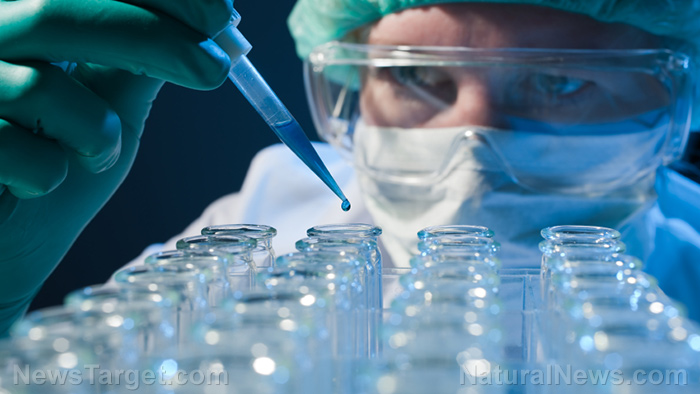Aluminum adjuvants in vaccinesMonday, December 04, 2017

(
Natural News) How do you express a legitimate concern about aluminium adjuvants in vaccines without being labelled as ‘anti-vaccine’?
(Article by Chris Exley republished from
Hippocraticpost.com)
We are studying the role and efficacy of aluminium adjuvants used in vaccines. We have been researching the impact of aluminium on life for more than 30 years and we are applying this experience to our understanding of aluminium adjuvants and how they work in vaccines.
- Quote :
- We have been researching the impact of aluminium on life for more than 30 years and we are applying this experience to our understanding of aluminium adjuvants and how they work in vaccines.
So, why are aluminium salts effective as adjuvants and why do we use them? The latter is easily answered. They are extremely cheap, essentially they cost nothing relative to other vaccine constituents, and there are absolutely no regulations as to the use of aluminium salts, either as adjuvants or otherwise. Adjuvants, including aluminium-based, are effective because of their toxicity at the vaccine injection site.
One of the most effective adjuvants is Freund’s Complete Adjuvant (a preparation of dried and inactivated mycobacteria) but this adjuvant is too toxic to be used in human vaccinations.
Aluminium salts are the most widely used adjuvants because their toxicity at the injection site is deemed acceptable in the light of the advantage gained from vaccination against the particular antigen.
The toxicity induced by aluminium adjuvants at injection sites is almost certainly due to the free aluminium cation, Al3+, which is released from the injected aluminium salt.
The cell death which is a consequence of the toxicity results in an inflammatory response and this is the origin of the swollen red tissue at the injection site almost immediately following vaccination.
The toxicity of an aluminium adjuvant depends upon the
aluminium salt with aluminium hydroxyphosphate (known commercially as AdjuPhos

) being more toxic at the injection site than aluminium oxyhydroxide (known commercially as AlHydrogel

). The aluminium adjuvant used in the Gardasil HPV vaccine is a sulphated version of aluminium hydroxyphosphate and is likely, based upon what we know about aluminium chemistry, to be even more toxic.
Unfortunately, Merck, the manufacturers of this adjuvant have not made it available for any independent analyses, never mind safety testing. The visual evidence of the toxicity of aluminium adjuvants at the injection site is limited by their intramuscular administration (the adjuvant is hidden away in the muscle tissue) while their actual injection site toxicity is experienced by many as significant muscular pain, and associated events, in the receiving limb which can last for hours and even days. However, the role of the injection site toxicity is to attract a variety of immune-responsive cells and these cells proceed to load up their cell cytoplasm with particles of aluminium adjuvant as well as antigen, the latter may or may not be associated with the adjuvant material. Thereafter, dogma dictates that the delivery of antigen to lymph nodes initiates antigen-specific adaptive immunity.
We have recently learned that the migratory cells which populate the injection site following vaccination are capable of loading up their cell cytoplasm with particles of aluminium adjuvant without these particles having any immediate effect upon
cell viability . These immune-responsive cells are subsequently found in lymph nodes but they are also capable of transporting their cargo of aluminium throughout the body including
gaining access to the brain.
These aluminium-loaded migratory cells remain viable in the shorter term because the particulate aluminium salt in their cytoplasm is enclosed in membrane-bound vesicles. However, these vesicles undergo a progressive acidification which in turn dissolves the enclosed aluminium salt to release biologically reactive Al3+ which will eventually cause the membrane-bound vesicle to rupture and consequently release large amounts of biologically available aluminium into the cell cytoplasm. The inevitable consequence of this is cell death and where this cell death occurs will simply depend upon the trajectory of the cells upon leaving the vaccine injection site. Theoretically at least this is a mechanism whereby a significant, indeed acute, amount of aluminium could be released into areas distant from the injection site such as brain tissue.
It is undeniable that a small proportion of individuals receiving vaccines which include aluminium adjuvants experience what have been called severe adverse events and such ‘events’ include brain encephalopathies. These severe adverse events are almost certainly caused by aluminium adjuvants and recent research showing how immune-responsive cells load up their cytoplasm with particulates of aluminium now offers mechanistic insight into how aluminium adjuvants are not only always toxic at the vaccine injection site but how they can occasionally be toxic at distant sites in the body too. Why some individuals are more susceptible to toxicity due to aluminium adjuvants is the subject of ongoing research.
So, in returning to my original question: How do you express a legitimate concern about aluminium adjuvants in vaccinations without being labelled as ‘anti-vaccine’?
The answer appears to be that you cannot. For example, since we started to research aluminium adjuvants two new ‘search options’ have appeared when Chris Exley is typed into Google, these options are ‘Chris Exley Vaccines’ and ‘Chris Exley Quack’!!
Read more at:
Hippocraticpost.com and
Aluminum.news.
